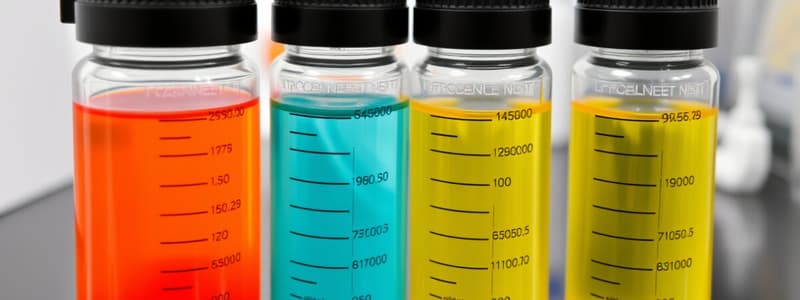Podcast
Questions and Answers
Which condition is NOT a direct cause of metabolic acidosis?
Which condition is NOT a direct cause of metabolic acidosis?
- Diabetic ketoacidosis
- Starvation
- Renal failure
- Hyperventilation (correct)
When calculating the anion gap, which ions are used in the formula?
When calculating the anion gap, which ions are used in the formula?
- Na+ and Cl
- Na+ and HCO3 + Cl (correct)
- Cl and Ca2+
- Na+ and HCO3
What is a possible consequence of hyperventilation in metabolic acidosis?
What is a possible consequence of hyperventilation in metabolic acidosis?
- Compensatory increase in respiratory rate (correct)
- High plasma chloride levels
- Increase in plasma pCO2
- Decrease in bicarbonate concentration
Which of the following is NOT a cause of metabolic alkalosis?
Which of the following is NOT a cause of metabolic alkalosis?
Which condition can lead to fluid losses below the gastric sphincter and contribute to acidosis?
Which condition can lead to fluid losses below the gastric sphincter and contribute to acidosis?
What is a common cause of excessive CO2 retention leading to partially compensated acidosis?
What is a common cause of excessive CO2 retention leading to partially compensated acidosis?
In a case of fully compensated metabolic acidosis, what would be a likely change in arterial blood gas values?
In a case of fully compensated metabolic acidosis, what would be a likely change in arterial blood gas values?
What type of respiratory condition is characterized by a pH of 7.34, pCO2 of 59, and HCO3 of 28?
What type of respiratory condition is characterized by a pH of 7.34, pCO2 of 59, and HCO3 of 28?
What effect does the addition of acid or base have on a buffered solution as long as the components are not depleted?
What effect does the addition of acid or base have on a buffered solution as long as the components are not depleted?
What factor is least likely to lead to decreased lung surface area participating in gas exchange?
What factor is least likely to lead to decreased lung surface area participating in gas exchange?
Which of the following could indicate respiratory alkalosis due to hyperventilation?
Which of the following could indicate respiratory alkalosis due to hyperventilation?
In the context of arterial blood gas analysis, what does pCO2 primarily indicate?
In the context of arterial blood gas analysis, what does pCO2 primarily indicate?
Which of the following pH values falls within the normal range for blood?
Which of the following pH values falls within the normal range for blood?
What is the normal range for bicarbonate (HCO3) levels in the blood?
What is the normal range for bicarbonate (HCO3) levels in the blood?
Which of the following conditions can be identified through blood gas analysis?
Which of the following conditions can be identified through blood gas analysis?
Which component is NOT typically involved in acid-base regulation?
Which component is NOT typically involved in acid-base regulation?
What defines a fully compensated acid-base status?
What defines a fully compensated acid-base status?
What is the main focus of the Anion Gap calculation in metabolic conditions?
What is the main focus of the Anion Gap calculation in metabolic conditions?
What is the primary way to eliminate non-volatile acids from the body?
What is the primary way to eliminate non-volatile acids from the body?
Which of the following statements is true regarding bicarbonate reabsorption in the kidneys?
Which of the following statements is true regarding bicarbonate reabsorption in the kidneys?
What occurs during respiratory acidosis?
What occurs during respiratory acidosis?
Which acidic condition corresponds with decreased bicarbonate levels?
Which acidic condition corresponds with decreased bicarbonate levels?
Which step of basic ABG interpretation involves evaluating the metabolic status?
Which step of basic ABG interpretation involves evaluating the metabolic status?
What is the physiological consequence of a rise in hydrogen ion concentration in the blood?
What is the physiological consequence of a rise in hydrogen ion concentration in the blood?
What is the hallmark of metabolic alkalosis?
What is the hallmark of metabolic alkalosis?
Which component of the acid-base balance is primarily impacted by the kidneys?
Which component of the acid-base balance is primarily impacted by the kidneys?
What is the primary cause of HCO3 retention in metabolic acidosis?
What is the primary cause of HCO3 retention in metabolic acidosis?
Which condition is likely to cause loss of HCO3 due to gastrointestinal processes?
Which condition is likely to cause loss of HCO3 due to gastrointestinal processes?
Which of the following is NOT a typical method of HCO3 loss?
Which of the following is NOT a typical method of HCO3 loss?
What compensatory mechanism occurs in response to metabolic acidosis?
What compensatory mechanism occurs in response to metabolic acidosis?
Which statement about anion gap in metabolic acidosis is true?
Which statement about anion gap in metabolic acidosis is true?
Which type of anion gap is associated with high metabolic acid production?
Which type of anion gap is associated with high metabolic acid production?
What is the typical timeframe for maximal compensation in metabolic acidosis?
What is the typical timeframe for maximal compensation in metabolic acidosis?
Which of the following is a possible effect of diuretic therapy related to acid-base balance?
Which of the following is a possible effect of diuretic therapy related to acid-base balance?
Flashcards are hidden until you start studying
Study Notes
Buffers
- Buffers resist changes in pH upon the addition of acids or bases, provided that their acidic or basic forms remain intact.
Blood Gas Analysis
- Essential for diagnosing acid-base balance, oxygenation status, and respiratory abnormalities.
- Components include pH (normal range: 7.35 - 7.45), pCO2 (normal range: 35-45 mmHg), and HCO3 (normal range: 22-26 mEq/L).
Interpretation of Arterial Blood Gas (ABG) Analysis
- Steps:
- Evaluate pH to determine acid-base status.
- Assess respiratory status via pCO2 levels.
- Evaluate metabolic status through HCO3 levels.
- Identify which regulatory system is responsible for imbalances.
Acid-Base Compensation
- Uncompensated: primary disturbance evident in pH values.
- Partially compensated: both respiratory and metabolic factors affect pH.
- Fully compensated: normal pH achieved despite underlying disorder due to compensatory mechanisms.
Respiratory Disorders
- Respiratory Acidosis: Increased CO2 leads to decreased pH (e.g., airway obstruction, respiratory depression).
- Respiratory Alkalosis: Decreased CO2 causes increased pH (e.g., hyperventilation).
Metabolic Disorders
- Metabolic Acidosis: Decreased HCO3 leads to decreased pH (e.g., diarrhea, renal failure).
- Metabolic Alkalosis: Increased HCO3 causes increased pH (e.g., vomiting, diuretic use).
Anion Gap
- Used to determine causes of metabolic acidosis.
- Calculated as sodium minus the sum of bicarbonate and chloride (Na+ – (HCO3 + Cl)).
- High anion gap indicates potential metabolic acidosis from non-volatile acids; normal anion gap indicates gastrointestinal bicarbonate loss.
Causes of Metabolic Disorders
- Metabolic Acidosis: causes include diabetic ketoacidosis, sepsis, and renal failure.
- Metabolic Alkalosis: caused by loss of acid via vomiting, diuretics, or alkali ingestion.
Compensation Mechanisms
- Respiratory compensation for metabolic acidosis involves increased breathing rate to expel CO2.
- In metabolic alkalosis, hypoventilation occurs to retain CO2, attempting to increase acidity back toward normal levels.
Clinical Context
- ABG analysis aids in forming comprehensive treatment plans for patients with respiratory and metabolic disturbances, allowing for targeted interventions based on underlying causes and compensation status.
Studying That Suits You
Use AI to generate personalized quizzes and flashcards to suit your learning preferences.



